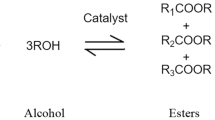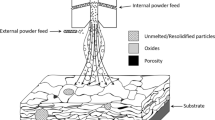Summaries
Inorganic-organic hybrid coatings were prepared using bodied soybean oil with sol-gel precursors. Three precursors, titanium tetra-i-propoxide (TIP), titanium (di-i-propoxide) bis (acetylacetonate) (TIA) and zirconium tetra-n-propoxide (ZrP) were evaluated at three different concentrations (wt %). Coating properties of hardness, crosshatch adhesion, reverse impact resistance and flexibility were obtained as a function of sol-gel precursor. In addition glass transition temperature and elastic modulus were determined. The addition of different types of these precursor at 5, 10, and 15 wt % concentrations imparted hardness without adversely affecting flexibility. The optimum hardness and flexibility coating properties were obtained at a 10 wt % precursor concentration. The reverse impact resistance decreased at a 15 wt % precursor concentration. The system containing TIP (10 wt %) exhibited the best coating properties in comparison with TIA and ZrP systems.
Résumé
On a préparé des hybrides revêtements inorganiques-organiques en se servant d’huile de soja corsée et des sol-gel précurseurs. Trois de ces précurseurs, tétraisopropoxyde de titane (TIP), (diisopropxyde) bis (acétylacétonate) de titane (TIA) et tétra -n-propxyde de zirconium étaient évalués à trois diverses concentations (% par poids). Les caractéristiques des revêtements telles que dureté, adhérence sous quadrillage, résistance à choc à l’inverse et flexibilité ont été déterminées en tonction du sol-gel précurseur. En plus, la température de transition vitreuse et la module d’élasticité ont été déterminées également. L’incorporation de divers types de précurseurs aux concentrations en pourcentage par poids de 5, 10 et 15 ont rendu dureté sans aucune influence défavorable sur la flexibilité. La dureté et la flexibilité optimale ont été obtenues à une concentration de 10% par poids de précurseur. Le système contenant 10% par poids de TIP a mis en évidence un revêtement ayant les meilleures caractéristiques en comparaison aux systèmes à base de TIA ou ZrP.
Zusammenfassung
Mischformige Anorganisch-Organischbeschichtungsstoffe wurden aus Dicksojaöl mit Sol-Gelverläufer hergestellt. Drei Sol-Gelvorläufer, Titantetraisopropoxid (TIP), Titan (diisopropoxid) bis (acetylacetonat) (TIA) und Zirkontetra-n-propoxid (ZrP) wurden an drei verschiedenen Konzentrationen bewertet. Beschichtungsstoffeseigenschaften wie Härte, Gitterschnittsadhäsion, Umkehrschlagfestigkeit und Flezibilität wurden als eine Eigenschaft des Sol-Gelvorläufers bekommen. Zusätlich wurden die Glasumwandlungstemperatur und Elastizitätsmodul bestimmt. Der Zusatz verschiedener Arten der Sol-Gelvorläufer an Konzentrationen (gew. %) von 5, 10 und 15 gibt Härte ohne jede Flexibilitatsschadigung. Die optimalen Härte- und Flexibilitatseigenschaften der Beschichtungen wurden an einer Sol-Gel-vorläuferkonzentratio an 10% (gew.). Jedoch, vermindert die Umkehrschlagfestigkeit an einer 15% (gew.) Konzentration. Der Systeme mit dem Sol-Gelvorläufer TIP (10% (gew.)) zeigte die besten Eigenschaften in Vergleich den TIA- und ZrP systemen.
Similar content being viewed by others
References
Oil and Color Chemists Association, Australia, in Surface Coatings, Vol. 1-Raw Materials and their Usage, Chapman and Hall Ltd. New York, 1983, pp. 20–44.
Wicks ZW, FN Jones and SP Pappas, inOrganic Coatings Science and Technology, Vol. 1, Wiley Interscience, New York, 1992, pp. 133–143.
May CA,Epoxy Resins Chemistry & Technology, New York, 1988.
Teng G and MD Soucek, ‘Epoxidized Soybean Oil Based Ceramer Coatings,’J. Am. Oil Chem. Soc.,77, 381, 2000.
Powers PO, ‘Heat Bodying of Drying Oils’,J. Am. Oil Chem. Soc.,27, 468, 1950.
Bloom AV,Fette U. Seifen,44, 107, 1937.
Bakelite Ltd, British patent, 507, 770, 1939.
Boelhouwer C, J Kneatel and M Tels, ‘On the Mechanism of the Thermal Polymerization of Linseed Oil’,Fette U. Seifen,69, 432, 1967.
Mills J and R. White, inNatural Resins of Art and Archaeology, Wiley Interscience, New York, 26, 1977.
Teng G, RJ Wegner, JG Hurtt and MD Soucek, ‘Novel Inorganic-Organic Hybrid Materials Based on Blown Soybean Oil with Sol-Gel Precursors,’Prog. Org. Coat., in Press.
Tukon Hardness Tester, Instruction Book, Wilson Mechanical Instrument Division, American Chair and Cable Company, Inc., 230 Park Avenue New York, NY 10017.
Hill LW, ‘Structure/property relationship of thermoset coatings’,J. Coat. Technol.,64, 808, 1992.
Kozosato, The Hardness of Coating Films,Prog. Org. Coat.,8, 1, 1980.
Zosel A, ‘Mechanical Behavior of Coating Films’,Prog. Org. Coat.,8, 47, 1980.
Wold CR, H Ni and MD Soucek, ‘A Model compound Study on the Interaction Between the Inorganic and Organic Phases in Drying Oil-Based Ceramer Coatings’,Materials Chem. J., in Press.
Okado M, K Tachikawa and K Aoi,J. Polym. Sci., Part A: Polym. Chem. 35, 2729, 1997.
Hill LW,Proc. XIIth Internat. Conf. Org. Coat. Sci. Technol., Athens, Greece July 1986.
Author information
Authors and Affiliations
Corresponding author
Rights and permissions
About this article
Cite this article
Deffar, D., Teng, G. & Soucek, M.D. Inorganic-organic hybrid coatings based on bodied soybean oil. Surface Coatings International Part B: Coatings Transactions 84, 147–156 (2001). https://doi.org/10.1007/BF02699777
Issue Date:
DOI: https://doi.org/10.1007/BF02699777




